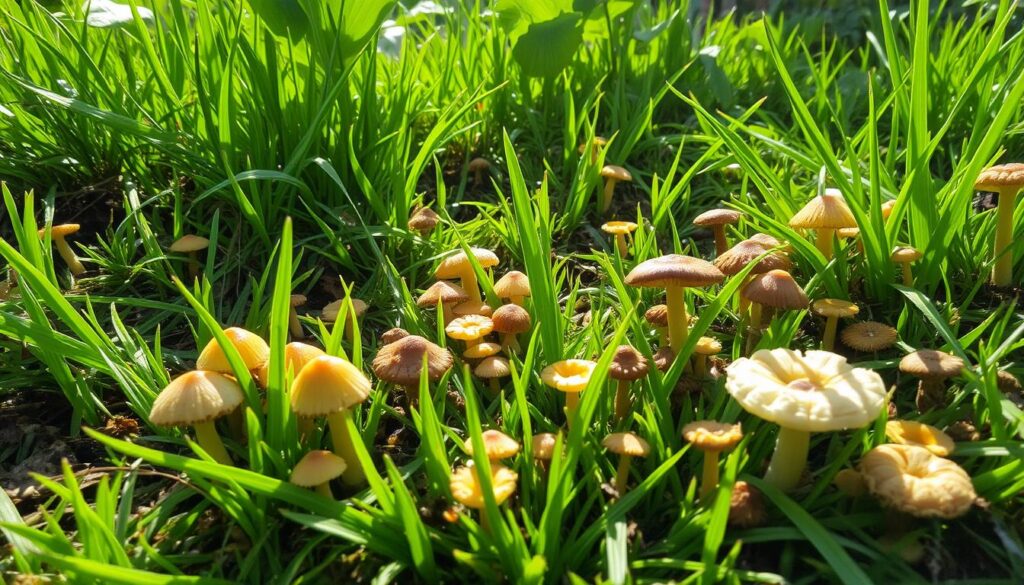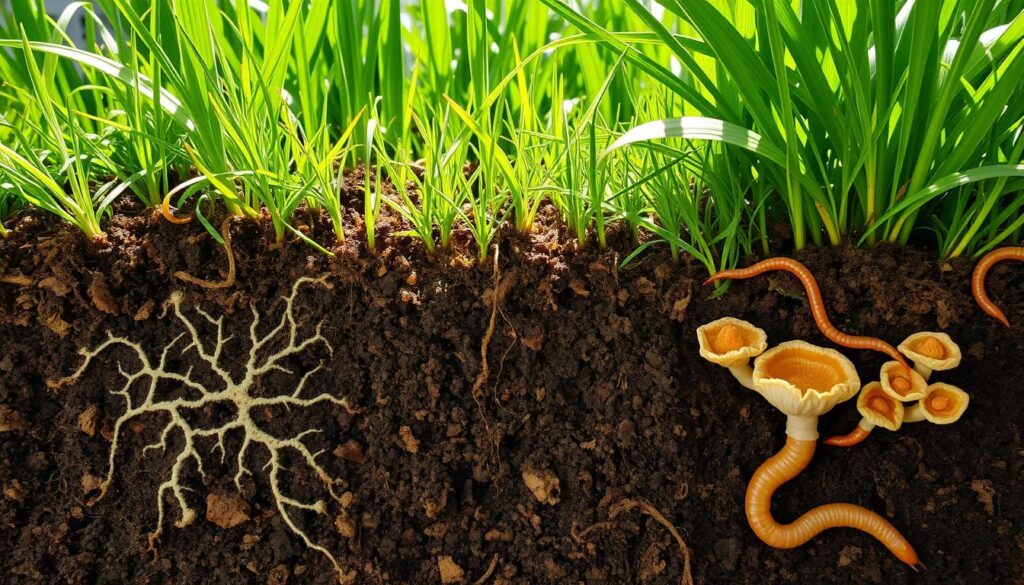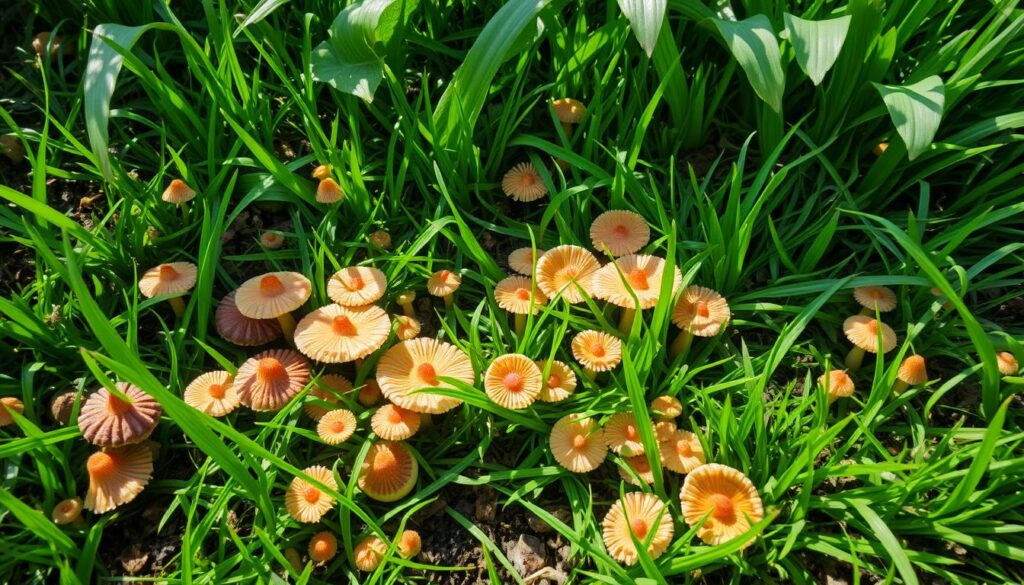Imagine a lush, green lawn under the warm sunlight. The grass sways gently in the breeze, with wildflowers adding color. But, what’s beneath this beauty? An unseen world of fungi works hard to keep it alive.
Fungi are key to a healthy lawn, not just for looks. They help with soil health, nutrient cycling, and lawn resilience. Knowing how fungi and grass work together can make your lawn care better. It can make your lawn more beautiful and last longer.

Fungi are nature’s recyclers and nutrient providers. They improve soil quality and help grass roots grow. Their complex networks are vital for a strong lawn.
In the next parts, we’ll explore how to use fungi for better lawn care. We’ll show you how to create a green space that can face time and weather challenges.
Key Takeaways
- Fungi play a vital role in building a resilient lawn.
- Understanding fungi’s importance can improve lawn care.
- Fungal networks boost soil health and nutrient cycling.
- Beneficial fungi help grass grow stronger.
- More fungal diversity means a healthier, more vibrant lawn.
Understanding the Importance of Fungi in Lawn Care
Fungi are key players in lawn care, helping to create healthy ecosystems. They improve soil structure by holding moisture and air better. This makes it easier for grass and plants to grow strong.
Fungi break down organic matter, making nutrients available to plants. This helps plants develop strong roots. Strong roots support the health of the lawn.
Also, fungi add to the diversity of soil life. Healthy ecosystems need this diversity. Knowing how fungi work shows their vital role in lawn health.
What Are Fungal Networks in Lawns?
Fungal networks, also known as mycelium, are key in both managed and natural areas. They form a vast web under the soil. This web helps plants share nutrients, boosting their health.
These networks also help lawns hold water better and stay stable. Lawns with strong fungal networks are more resilient to stress. This makes the ecosystem stronger, helping grass and other plants grow well.
Let’s look at some benefits:
| Feature | With Fungal Networks | Without Fungal Networks |
|---|---|---|
| Nutrient Exchange | Enhanced and efficient | Limited and slow |
| Water Retention | Increased capacity | Regular depletion |
| Soil Stability | High | Low |
| Plant Resilience | Improved | Reduced |
The Role of Fungi in Building a Resilient Lawn
Fungi play a big role in making lawns strong. They create networks that help grass roots grow. This lets lawns do well even when things get tough.
These beneficial relationships between fungi and grasses make the lawn healthier. It becomes more able to handle stress like drought, pests, and diseases.
Fungi help lawns absorb nutrients better by growing the roots deeper. This means grasses can get the nutrients they need. As a result, the plants stay healthy and can handle different weather conditions.
To make lawns more resilient, we need to help fungi grow in the soil. By doing this, we can reduce the need for harmful chemicals. It also makes lawn care more sustainable in the long run.
Benefits of Fungi for Soil Health
Fungi are key to better soil health. They help in many ways, making them vital for lawns and ecosystems. They break down organic matter, releasing nutrients back into the soil.
This process is called nutrient cycling. It’s important for the soil’s health.
Fungi also improve soil structure. Mycorrhizal fungi create networks that hold soil particles together. This makes the soil better at holding water and air.
With better aeration, roots can grow deeper. This leads to stronger grass that can fight off pests and diseases.
Fungi help plants take in nutrients, which is great for healthy lawns. They work with plants to extend the root system. This makes it easier for grass to get water and nutrients.

“The harmonious relationship between soil fungi and plants enhances not just their survival, but overall ecosystem health.”
In short, using fungi in soil management is very beneficial. They help with nutrient cycling, improve soil structure, and feed plants. This shows how important mycorrhizal fungi are for sustainable and strong lawns.
Improving Lawn Health with Fungi
Fungi are key to a healthy lawn, making grass strong and green. By knowing about the different fungi, homeowners can get a lush lawn. This is because fungi help make nutrients available.
Types of Beneficial Lawn Fungi
There are many types of beneficial lawn fungi that help grass grow well. Here are a few:
- Mycorrhizal fungi: These fungi work with grass roots to get moisture and nutrients.
- Decomposer fungi: They break down dead plants, giving nutrients back to the soil.
- Endophytic fungi: Living inside grass, they fight pests and make grass stronger.
How Fungi Enhance Nutrient Availability
Fungi make nutrients available to grass, improving its health. They do this by:
- Breaking down complex organic materials: Fungi turn organic matter into nutrients that grass can use.
- Improving soil structure: Their growth helps the soil hold water and air better.
- Facilitating nutrient cycling: Fungi help move nutrients around in the soil, so grass gets what it needs.
Using fungi is good for the grass and the whole lawn. It leads to better lawn care that’s good for the environment.
Mycorrhizae: A Key Player in Lawn Resilience
Mycorrhizae are key to a healthy lawn. They connect with plant roots, forming strong bonds. These bonds help the lawn grow strong and stay healthy.
Symbiotic Relationships Between Fungi and Grass
Mycorrhizae are a team effort between fungi and grass roots. Fungi help plants get nutrients and water. In return, plants give fungi food from sunlight.
This partnership is vital, more so in poor soil. Regular fertilizers might not be enough.
Mycorrhizal Fungi and Soil Quality
Mycorrhizal fungi greatly improve soil quality. They make the soil better for plants to grow. This leads to healthier plants and a stronger lawn.
By adding these fungi, lawns become more resistant to drought and disease. This makes for a more resilient landscape.

Improving Lawn Resilience with Fungi
Improving lawn resilience with fungi involves several strategies. These strategies focus on the role of fungi in lawn resilience. They aim to use fungi’s natural growth and interaction with grass roots.
Creating an environment for fungi to grow is key. This allows fungal networks for a healthy lawn to develop.
Using organic amendments, like compost, is a good method. These amendments help fungi grow, improving soil structure and moisture retention. Healthy fungi help cycle nutrients, making grass stronger against stress.
Regular soil aeration is also helpful. It boosts oxygen for fungi, helping them spread. A well-aerated lawn with good drainage supports various fungi, boosting overall resilience.
In summary, improving resilience with fungi needs a mix of approaches. Using organic amendments and maintaining soil conditions greatly benefits lawn health. This leads to a strong landscape that can face environmental challenges well.
Fungi and Lawn Maintenance Strategies
Keeping your lawn healthy means managing fungi well. It’s important to know how to help good fungi and stop bad ones. This part talks about how to manage lawn fungus and prevent problems.
Effective Lawn Fungus Management Techniques
Here are some ways to manage lawn fungus:
- Regular Aeration: Aerating helps good fungi grow by improving air flow.
- Moisture Management: Watering in the morning helps avoid too much moisture, which bad fungi don’t like.
- Fungal Inoculation: Adding good fungi can beat out the bad ones and make grass stronger.
- Proper Nutrition: Using the right fertilizers helps the lawn overall, which helps good fungi too.
Preventative Measures for Fungal Issues
Stopping fungus problems before they start is key. Here are some ways to do that:
- Keep the soil pH right to make it hard for bad fungi to grow.
- Follow a good mowing schedule to keep air moving and stop disease.
- Add organic matter to the soil to help it and the good fungi.
- Watch the weather to avoid times when fungi can grow too well.
Promoting Fungal Diversity for Lawn Vitality
Having a diverse fungal community in lawns is key for their health and vitality. It’s important to know what affects fungal diversity. This knowledge helps in creating a better environment for these beneficial organisms. It also boosts the lawn’s overall health.
Factors Affecting Fungal Diversity
Several factors impact the variety of fungi in lawns. These include:
- Soil composition and fertility
- Moisture levels and drainage
- Temperature fluctuations
- Type of grass and its growth conditions
- Human actions like mowing, fertilizing, and pest control
These factors shape the environment where some fungi do well while others struggle. Knowing these factors affecting fungal diversity helps in making lawns more resilient.
Benefits of a Diverse Fungal Community in Lawns
Encouraging fungal diversity in lawns brings many ecological benefits:
- Nutrient Cycling: A variety of fungi helps break down organic matter. This makes nutrients available to grass roots.
- Pest Management: A diverse fungal community can naturally control pests. This reduces the need for chemical treatments.
- Soil Structure Improvement: Different fungi help form soil aggregates. This improves soil aeration and water retention.
- Resilience to Stress: A diverse fungal ecosystem helps lawns handle environmental changes and stress better.
Investing in promoting fungal diversity in lawns improves their look and supports their sustainability.
Enhancing Lawn Vitality with Fungi
Using fungi in lawn care boosts enhancing lawn vitality with fungi. Fungi help plants grow strong by working with nature. They make the grass and soil healthier, which is good for the environment and saves resources.
Adding fungi to lawn care means using natural lawn care with fungi methods. These methods help grass grow by making nutrients easier to get and improving soil. A healthy mix of fungi helps break down organic matter, making it easier for plants to use. This leads to strong grass that can handle tough weather.

| Approach | Benefits | Example Fungi |
|---|---|---|
| Soil Inoculation | Boosts fungal populations, improving nutrient uptake | Mycorrhizae |
| Organic Amendments | Provides food sources for fungi, promoting growth | Trichoderma |
| Resistant Strains | Helps grass resist diseases while enriching vigor | Basidiomycetes |
Using these methods makes a lawn ecosystem come alive. The connection between fungi and healthy grass makes the lawn strong against pests and diseases. Homeowners can get a beautiful lawn by using these natural ways, which also helps the planet.
Conclusion
Understanding fungi’s role in lawn health is key for lawn care enthusiasts. Fungi improve soil health and boost lawn vitality. This creates a thriving environment for grass growth, reducing the need for chemicals.
Studies show fungi help lawns by improving nutrient uptake and plant resilience. Using beneficial fungi in lawn care makes landscapes healthier and supports sustainability. Insights from “The Future of Sustainable Lawn Practices” and “Lawn and Soil Health: A Review” highlight the importance of these ecological principles.
Learning more about fungi will help us create lush, sustainable outdoor spaces. By embracing these findings, we can preserve and promote fungal networks for better lawn health.
FAQ
What is the role of fungi in building a resilient lawn?
Fungi play a big role in making lawns strong. They help improve soil health and make nutrients available. Their networks connect roots, helping plants share resources.
How do fungi benefit lawn health?
Fungi help lawns by breaking down organic matter. They also improve soil structure and make nutrients easier to get. This leads to healthier grass and better defense against pests and diseases.
What are mycorrhizal fungi, and why are they important for lawns?
Mycorrhizal fungi work with plant roots to improve water and nutrient uptake. They are key to better soil quality and a stronger lawn.
How can I incorporate fungi into my lawn care routine?
To add fungi to your lawn care, use soil amendments like mycorrhizal inoculants. Organic practices also help keep fungi levels healthy, supporting a strong lawn ecosystem.
What strategies are effective for managing lawn fungi?
Managing lawn fungi involves regular aeration and keeping moisture right. Use fungicides wisely. Also, promote good fungi while controlling bad ones through cultural practices.
Why is promoting fungal diversity important for lawns?
Diverse fungi are vital for a healthy lawn. They boost soil resilience, support nutrient cycling, and improve turfgrass health.
How can fungi improve soil health in lawns?
Fungi improve soil by breaking down organic matter and making nutrients available. They also help with soil structure and aeration. This leads to better water retention and supports grass growth.
What are some examples of beneficial lawn fungi?
Good lawn fungi include mycorrhizal and saprophytic fungi. Mycorrhizal fungi help with nutrient uptake, while saprophytic fungi break down dead matter. Both types are good for turfgrass health.
When is the best time to apply fungal treatments to lawns?
Apply fungal treatments when grass is actively growing, usually in spring and early fall. This helps the fungi work best during the grass’s peak growth times.
Can fungi help with drought resistance in lawns?
Yes, fungi help lawns resist drought by improving water retention and soil structure. Their networks help grass roots grow deeper, accessing moisture better.




